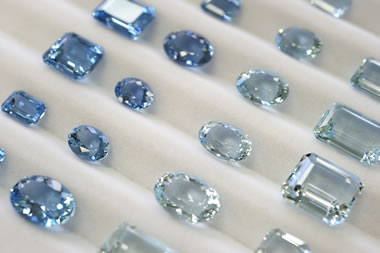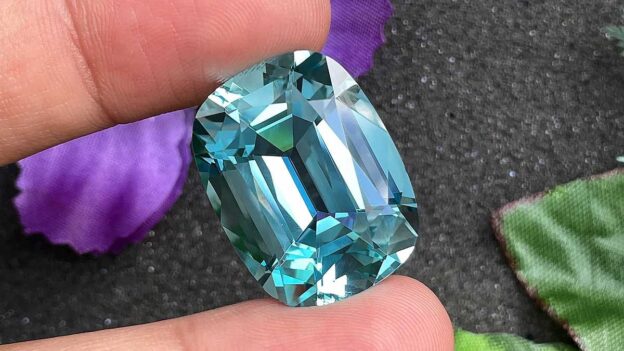Aquamarine is a stone, at first glance, discreet. The saturation of its color is not great, and a glance cast with chalk will define the blueness of the crystal as whitish, washed out, and watery. However, it is worth taking a closer look at the transparent stone, and it becomes clear: aquamarine is not easy, its dull appearance hides the advantages inherent in the noblest of the precious minerals.
The silvery inner shine of the stone was appreciated in ancient times. Pliny wrote about the high cost of crystals that matched the color of the sea wave. Paustovsky, fascinated by aquamarine, characterized it as a star-colored stone.
The aristocracy and the nobility of the whole world gladly used and uses aquamarines as a distinctive sign of their chosenness. The Armory of the Moscow Kremlin contains the sceptre of the Polish autocrat, completely carved from aquamarine. Britain, as the ruler of the seas, set the sea-colored stone into the imperial crown. Many exquisitely cut aquamarines are kept in private and museum collections in many countries.
Physical and chemical properties of aquamarine
- Chemical formula – Al2Be3 [Si6O18].
- The crystals are elongated-prismatic.
- Aquamarine color is blue, bluish-green.
- Transparency – translucent, transparent.
- The shine is glassy.
- Mohs hardness – 7.5.
- Density – 2.7 g / cm3.
- Refraction or refraction period – 1.574-1.580.
- Cleavage: absent.
- Fracture: conical, uneven.
- Crystal system: hexagonal.
- Is the mineral fragile: Yes
Aquamarine color
Not every aquamarine is the color of seawater. The stones mined in the middle Urals and beyond Lake Baikal are blue. South Ural aquamarines found in the Ilmen mountains are greenish.
The crystals of aquamarines mined in South America can have a very thick blue color. About a hundred years ago, a sapphire blue aquamarine deposit was discovered in Brazil.
Unfortunately, the color stability of these stones turned out to be even more phenomenal than the color itself. Even a short exposure to the bright sun caused the crystals to fade. For several days of “acquaintance” with daylight, the crystals changed color from washed-out blue to dirty yellow, yellow-brown and even earthy color.
The instability to intense electromagnetic radiation of the visible spectrum and adjacent ranges is inherent in all aquamarines. Some specimens of the stone, as noted by Fersman, have indistinct color zoning. The peripheral regions of the crystalline body of aquamarine have a bluish-blue color, the central region glows with yellowness. It is the mixing of the yellow color of the inner zone of the crystal and the blue color of the outer layers that gives a green tint to the overall color of the stone.
Similar, but not aquamarine
Weakly colored blue spinels resemble aquamarine, but they cannot be compared with the famous gem in gem quality. Spinels are characterized by gaseous inclusions in the stone mass, visible as tiny bubbles. Aquamarines have no such defects.
Similar to aquamarine and topaz. However, topaz shines brighter and gives a much richer play of refracted light. From a certain angle of view, in the thickness of the faceted flat aquamarine, a silvery reflection is noticeable, in the shape of a chrysanthemum flower. Topaz is not capable of such “art”.
The high (up to 70%) quartz content in natural aquamarine gives fraudsters the hope of imitating natural stone with glass fakes. But glass tinted with cobalt salts does not have the dichroic effect inherent in aquamarine. A precious crystal (this is especially noticeable in artificial lighting) when changing the angle of incidence of light is seen differently. Tinted glass is the same for any type of observation.

Natural aquamarines of low color intensity can undergo pre-sale thermal preparation. Heating the stone to 400˚C in a muffle furnace “thickens” the color, intensifies the blue of the natural mineral. Irradiation of pale aquamarine with X-rays leads to similar results. “Improved” stones, however, often “show temper”, acquiring an unattractive color zoning or dirty tones in a uniform color.
In addition, this stone is even less resistant to sunlight than natural aquamarine.
The artificial cultivation of light blue and gem-quality beryls is not practised.
The magical properties of aquamarine
The high optical properties of natural aquamarine were used by ancient craftsmen: lenses were carved from large stones. Needless to say, in the minds of the people, aquamarine was considered, if not magical, then at least slightly supernatural mineral.
The mystical perception of bluish crystals thickened as much as possible by the Middle Ages when aquamarine began to be considered the lord of the water element. Every captain of a serious seagoing vessel was supposed to own a piece of jewellery with quality aquamarines. Repeated maritime failures were attributed to neglect of the stone.
The magical properties of aquamarine are still considered powerful today. The distinct blue color of the crystal indicates a transparent and bright perspective in the life of the owner. An unexpected color change towards green is a warning sign of possible trouble. Reducing the transparency of the stone is a warning of imminent personal troubles.
Wearing or daily tactile communication with a precious mineral makes a person bolder. The owner of aquamarine is easier to learn complex humanities – philosophy, political science, sociological disciplines.
The healing properties of aquamarine
Looking at a stone lit by fire or an incandescent lamp can help improve vision. However, aquamarine plays the main lithotherapeutic role in pain relief of the entire digestive tract. It is equally effective for toothache, liver pain, and hemorrhoidal pain.
By reducing the sensitivity of nerve endings, aquamarine helps to calm the nervous system as a whole. The beneficial effects of the stone help stabilize emotions and increase mental stamina.
Noticeable medicinal properties of aquamarine are also shown in the fight against diseases of the thyroid gland. Faceted blue crystals, collected in beads, enhance the effect of drugs, balance the synthesis of hormones, and prevent the development of thyrotoxicosis.
Aquamarine for the signs of the zodiac
The signs of Water can count on the full help of aquamarine. The stone is especially effective in relation to Pisces and Cancers. Zodiac Air signs may wear aquamarine jewellery from time to time, but Gemini is better off refraining from purchasing aquamarine jewellery.
Active Taurus cannot expect help from aquamarine: in the presence of such an energetic person, the stone closes, becomes spiritually inert. Aquamarine can bring frustration and failure to Sagittarius.
Talismans and amulets from aquamarine
Since ancient times, aquamarine has been the mascot of watermen. Whoever you work in the sea or river fleet, buy several aquamarines and keep them in your workplace or in your cabin!
Aquamarine amulet is the first assistant in smoking cessation. Less, but the bluestone also helps in the fight against alcohol abuse. Among other things, aquamarine amulets support creative and research activities. The stone, mentally tuned to good luck in solving complex scientific problems, helps to find the most rational way to solve the mysteries of nature.

